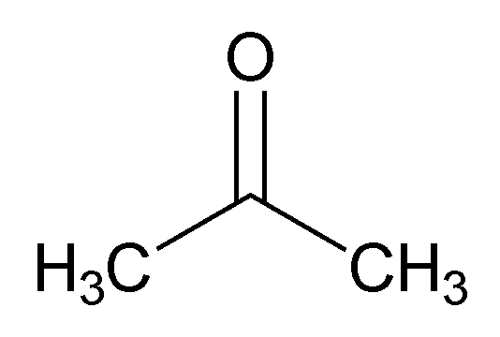Acetone
(as' e tone).
DEFINITION
Acetone contains NLT 99.0% of C3H6O, calculated on the anhydrous basis.
[Caution—Acetone is very flammable. Do not use where it may be ignited.
]
IDENTIFICATION
• B.
The retention time of the Sample corresponds to that of USP Acetone RS, as obtained in the Assay.
ASSAY
• Procedure
Sample:
Acetone
System suitability solution:
Dilute 1.0 mL of USP Methyl Alcohol RS and 1.0 mL of USP Acetone RS with tetrahydrofuran to 50 mL.
Chromatographic system
Mode:
GC
Detector:
Flame ionization
Column:
0.32-mm × 30-m fused-silica capillary; 1.8-µm of phase G43
Temperature
Column:
See Table 1.
Table 1
| Initial Temperature ( |
Temperature Ramp ( |
Final Temperature ( |
Hold Time at Final Temperature (min) |
|---|---|---|---|
| 40 | 0 | 40 | 5 |
| 40 | 20 | 240 | — |
Injector:
200
Detector:
280
Carrier gas:
Helium
Flow rate:
35 cm/s (linear velocity)
Split ratio:
400:1
Injection volume:
1 µL
System suitability
Sample:
System suitability solution
[Note—The relative retention times for methyl alcohol, acetone, and tetrahydrofuran are about 0.6, 1.0, and 1.9, respectively. ]
Suitability requirements
Resolution:
NLT 15 between the methyl alcohol and acetone peaks
Analysis
Sample:
Sample
Calculate the percentage of acetone (C3H6O) in the portion of Acetone taken:
Result = (rU/rT) × 100
| rU | = | = peak area due to the acetone peak in the Sample |
| rT | = | = sum of the areas of all the peaks in the Sample |
[Note—No separate correction is applied for water content, because water does not respond to the flame-ionization detector. ]
Acceptance criteria:
NLT 99.0% on the anhydrous basis
SPECIFIC TESTS
• Specific Gravity  841
841 :
NMT 0.789
:
NMT 0.789
• Nonvolatile Residue:
Evaporate 50 mL in a tared porcelain dish on a steam bath, and dry at 105 for 1 h.
for 1 h.
Acceptance criteria:
The weight of the residue does not exceed 2 mg (0.004%).
• Water
Sample:
Acetone
Standard solution:
Transfer 0.50 mL of water to a dry 100-mL volumetric flask, dilute with dehydrated isopropyl alcohol to volume, and mix.
Blank:
Dehydrated isopropyl alcohol
Chromatographic system
Mode:
GC
Detector:
Thermal conductivity
Column:
0.32-mm × 50-m capillary; 5.0-µm layer of support S2
Temperature
Column:
See Table 2.
Table 2
| Initial Temperature ( |
Temperature Ramp ( |
Final Temperature ( |
Hold Time at Final Temperature (min) |
|---|---|---|---|
| 100 | 25 | 190 | — |
Injector:
250
Detector:
250
Carrier gas:
Helium
Flow rate:
11 mL/min
Split ratio:
4.5:1
Injection size:
1.0 µL
Analysis
Samples:
Acetone, Standard solution, and Blank
[Note—Identify the peaks based on their relative retention times, which are 1.0 for water and about 1.9 for isopropyl alcohol. ]
Acceptance criteria:
The area of the water peak for Acetone is NMT that from the Standard solution, corrected for the area of the water peak from the Blank (0.5%).
• Readily Oxidizable Substances
Analysis:
Mix 20 mL with 0.10 mL of 0.10 N potassium permanganate in a glass-stoppered bottle.
Acceptance criteria:
The permanganate color of the mixture does not completely disappear within 15 min.
ADDITIONAL REQUIREMENTS
• Packaging and Storage:
Preserve in tight containers, remote from fire.
Auxiliary Information—
Please check for your question in the FAQs before contacting USP.
| Topic/Question | Contact | Expert Committee |
|---|---|---|
| Monograph | Robert H. Lafaver, M.S.
Scientific Liaison 1-301-816-8335 |
(EXC2010) Monographs - Excipients |
| Reference Standards | RS Technical Services 1-301-816-8129 rstech@usp.org |
USP35–NF30 Page 1682
Pharmacopeial Forum: Volume No. 34(1) Page 120

